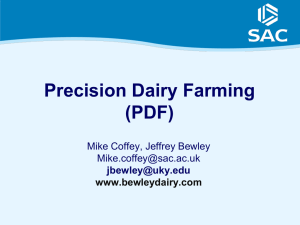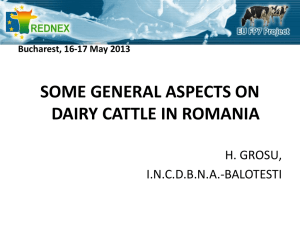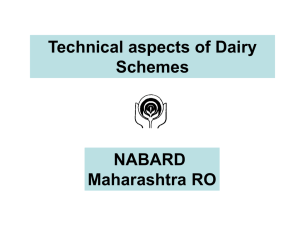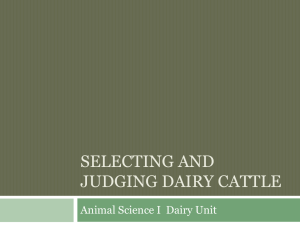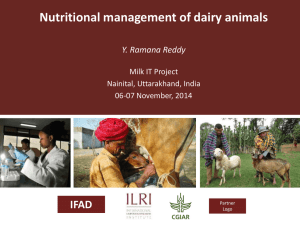Unit 9: Dairy Cattle Feeding
advertisement
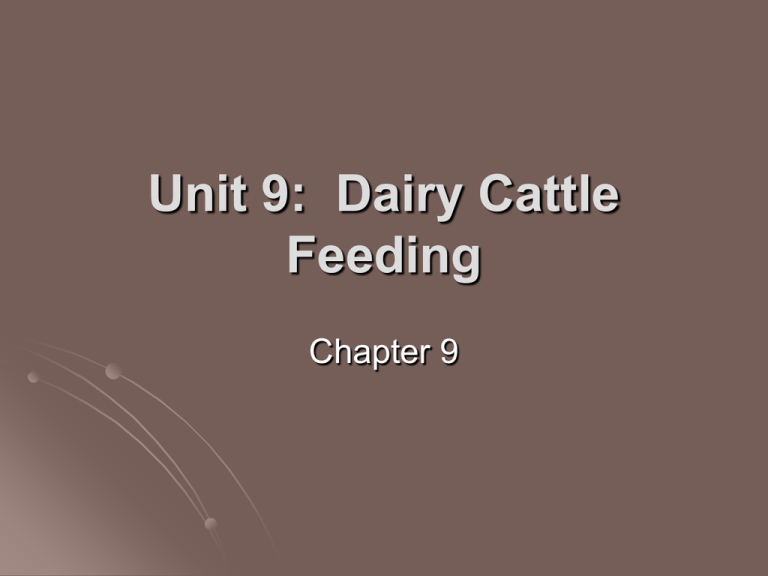
Unit 9: Dairy Cattle Feeding Chapter 9 Unit 9: Dairy Cattle Feeding Unit 9 Objectives: Discuss life-cycle feeding programs for dairy Identify nutrient needs and additives used Understand nutrition related diseases/disorders Unit 9: Dairy Cattle Feeding Feeding for Milk Production General What types of systems are in use for milk production in today’s industry? What influences which system is utilized? Feeding is often the determining factor in productivity of lactating dairy cows Represents 50% of the total cost of production Nutrient requirements for lactation are several times that of maintenance requirement Unit 9: Dairy Cattle Feeding Things to remember: There is more variation in protein content and quality and energy in forages & concentrates Primarily concerned with NEl, CP, DP, RUP, & AA contents of the ration Mineral content and interactions are becoming much more important and manipulated Forage Consumption Estimated daily intake of forages is based on body weight and forage quality What does forage quality have to do with it? Unit 9: Dairy Cattle Feeding Forage intake must be restricted somewhat to allow for sufficient grain supplementation to support milk production Silage can replace hay at a ratio of 3:1 Pasture intake will usually exceed silage intake Some evidence that increased feeding times can increase total forage consumption Increasing forage variety can also help increase consumption Unit 9: Dairy Cattle Feeding Concentrates for Dairy Cattle Concentrate mixture Grains, milled feeds, protein supplements, min/vit Mixture will vary with the forage program Consider availability and cost of nutrients Level of concentrate fed depends: Amount of forage consumed Milk production Milk fat composition NEVER feed over 60% concentrate in the diet – drastically changes VFA composition in the rumen – what health problems does it cause? Unit 9: Dairy Cattle Feeding Intake is affected by: Palatability Time they have access to feed How has feed access changes over the years? How did we used to offer feeds? Concentrate feeding levels should be appropriate for each operation No book-value is very accurate Can underfeed the high producer and overfeed the low producer Unit 9: Dairy Cattle Feeding Steps in Ration Balancing for Lactating Dairy Cattle Establish needs Maintenance plus milk production & reproductive needs Determine Forages Kind & quality Concentrate Mix Kind & amount Establish feeds available feeding levels Forage Appropriate for quality and production Unit 9: Dairy Cattle Feeding Concentrate Supply additional nutritional needs Balance Make sure protein & energy needs are met Evaluate forage : concentrate ratio Check protein sources and amino acid levels Ensure proper min/vit supplementation Feeding Guidelines Groups can be separated based on: Stage of lactation Age Dry period What groups can/should we have? Unit 9: Dairy Cattle Feeding Early Lactation or Post-fresh Group 0 – 60 or 70 DIM Milk production increases rapidly, peaks 6-8wks post-calving Avoid excessive levels of grain Encourage forage intake Keep it palatable High dietary protein Limit urea content Increase energy density (increase fat content) Unit 9: Dairy Cattle Feeding Peak Milk Highest DMI’s 60 – 140 DIM Maximal DMI during peak milk increases total milk production – each 1# peak milk = 300#’s milk in lactation Feed several times/d Maximize ration forage content without compromising energy, protein, and amino acids Mid to Late Lactation 140 DIM to dry period Milk production declines, cow is pregnant Unit 9: Dairy Cattle Feeding Match grain intake to milk production – be careful not to waste feed and over-condition cows Dry period (Far-Off) 21 – 60d prepartum High forage content Maintain body condition – don’t lose weight, maybe slight weight gain Enough grain and supplement to support CP, energy, and min/vit requirements Drop Ca supplementation levels Unit 9: Dairy Cattle Feeding Dry Period (Pre-fresh) 0 – 21d prepartum Increase ration energy & protein content Make ration more energy dense DMI’s reduced greatly prior to calving Manipulate ration min/vit concentrations to help with post-calving problems – what are the target problems DCAD Increase feed palatability Decrease stocking rate Maintain pen cleanliness Unit 9: Dairy Cattle Feeding Things to Remember Feed young growing cows for growth, as well as, milk production What about a separate first calf heifer group? More cows are usually underfed on energy than protein Balancing for amino acid content can help minimize overfeeding of protein Limit finely ground feedstuffs (except for grain) to prevent drop in milk fat test Inclusion of hay is recommended Unit 9: Dairy Cattle Feeding Have water available at all times 3-5 lbs of water/lb milk/d Adding Adding fat helps in early lactation to improve energy density Avoid excessive fat levels due to unpalatability and feed freshness problems bST fat use Begin at 9th week of lactation Increases milk production by 8-10lbs/d Does increase DMI Unit 9: Dairy Cattle Feeding Feed for Dairy Calves Common Feed for Calves Colostrum Remove calf from cow immediately Try to get 2 quarts on colostrum in within 30 min to 1 hr Milk replacer Various programs 20/20 Accelerated growth Antibiotics usually included Unit 9: Dairy Cattle Feeding Calf Starters Usually 16-20% CP Must be extremely palatable Antibiotic is recommended to help w/ respiratory and scour problems Encourage starter intake ASAP Wean when they eat 3 lbs/d for 3 consecutive days Calves with growth faster and more efficiently on dry feed Do not feed hay Unit 9: Dairy Cattle Feeding Heifers 4-12 mos of Age Need to supplement grain to help meet energy needs Rumen capacity isn’t sufficient to get all needs from forages alone Include an ionophore for improved rate of gain & feed efficiency DO NOT let them get over conditioned Decreases reproductive performance Decreases milk production capability Unit 9: Dairy Cattle Feeding Heifers 12 mos to calving Forage should be able to support their nutritional requirements Supplement enough grain to include min/vit and ionophores Target breeding weight is 800 lbs 550 for Jerseys Heifers must gain 1.75lbs/d to reach target wt by 15 mos Breed by weight Goal should be to have average first calving <24 mos Avoid over conditioning Some producers include straw or other high fiber components to slow down growth Unit 9: Dairy Cattle Feeding Mix with dry cow 60d prior to calving Minimum of 21d in a pre-fresh group Keep DMI and energy levels up Adjust to higher grain content and better quality forages
